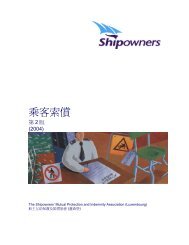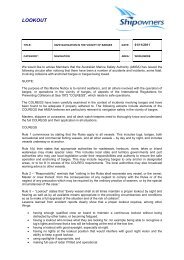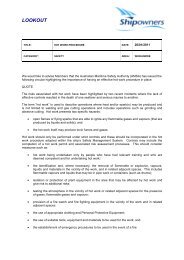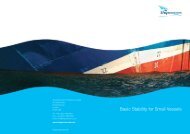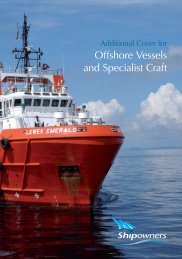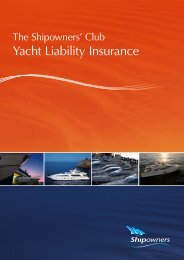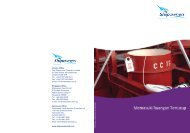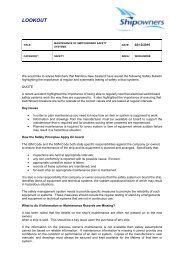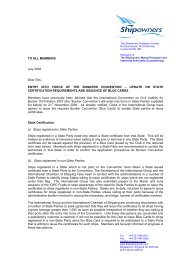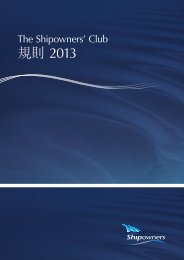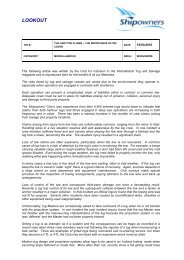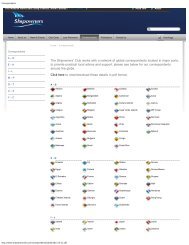BIMCO GUARDON contract for the employment of ... - Shipowners
BIMCO GUARDON contract for the employment of ... - Shipowners
BIMCO GUARDON contract for the employment of ... - Shipowners
You also want an ePaper? Increase the reach of your titles
YUMPU automatically turns print PDFs into web optimized ePapers that Google loves.
TO ALL MEMBERSMarch 2012<strong>BIMCO</strong> GUARDCON <strong>contract</strong> <strong>for</strong> <strong>the</strong> <strong>employment</strong> <strong>of</strong> security guards on vesselsMembers are referred to <strong>BIMCO</strong>’s GUARDCON <strong>contract</strong> <strong>for</strong> <strong>the</strong> <strong>employment</strong> <strong>of</strong> security guards onvessels (GUARDCON), published on 28 th March 2012.The decision as to whe<strong>the</strong>r to employ guards (whe<strong>the</strong>r armed or unarmed) is an operational one <strong>for</strong>Members. In making that decision Members must always comply with Flag State law as well as anyapplicable local laws. Members are also reminded <strong>of</strong> <strong>the</strong>ir obligation to follow <strong>the</strong> due diligenceprinciples set out in IMO MSC Circular 1405 1 toge<strong>the</strong>r with Best Management Practices (currentlyVersion 4, August 2011).Never<strong>the</strong>less, it has been recognised that <strong>the</strong> growth in <strong>the</strong> number <strong>of</strong> Private Maritime SecurityContractors (PMSCs), each with differing <strong>contract</strong>ual terms, has been resulting in uncertainty.Accordingly, to benefit <strong>the</strong> wider shipping community, <strong>BIMCO</strong> has developed GUARDCON, drafted bya working group comprising <strong>of</strong> shipowners, property underwriters, IG P&I Club representatives,maritime lawyers, representatives <strong>of</strong> security companies and o<strong>the</strong>r shipowner and marine insuranceassociations. GUARDCON is intended to harmonise terms <strong>of</strong> engagement <strong>of</strong> PMSC’s (described inGUARDCON as Contractors) as well as simplifying <strong>the</strong> processes <strong>for</strong> vetting and approval <strong>of</strong><strong>contract</strong>s by Members and <strong>the</strong>ir P&I Clubs.Members are reminded that GUARDCON does not represent a recommendation by <strong>BIMCO</strong> or <strong>the</strong>International Group <strong>of</strong> P&I Clubs <strong>for</strong>, or endorsement <strong>of</strong>, <strong>the</strong> use <strong>of</strong> security guards on board vessels.Nor are security guards a substitute <strong>for</strong> strict compliance with Best Management Practices. Placingsecurity guards on board a vessel should also only be considered after a risk assessment has beencarried out and <strong>the</strong> Master should be involved in <strong>the</strong> decision-making process. However, <strong>the</strong>provisions <strong>of</strong> GUARDCON have been reviewed by <strong>the</strong> International Group’s Maritime Securitysubcommittee and con<strong>for</strong>m with Club cover and Pooling requirements.GUARDCON addresses a number <strong>of</strong> key issues, including:standards to which <strong>the</strong> Contractor (PMSC) must con<strong>for</strong>m to in terms <strong>of</strong>:- providing adequate insurance to cover <strong>the</strong>ir liabilities and <strong>contract</strong>ual indemnities(which Members should verify) and- having in place <strong>the</strong> necessary permits and licences to allow <strong>the</strong>m to lawfully transportand carry weaponsliability and indemnity provisions based on knock <strong>for</strong> knock principles and<strong>the</strong> Master’s responsibility <strong>for</strong> <strong>the</strong> safe navigation and overall command <strong>of</strong> <strong>the</strong> vessel.1 MSC.1/Circ. 1405-Rev.1 Revised Interim Guidance to <strong>Shipowners</strong>, Ship Operators, and Shipmasters
If Members decide to use an amended version <strong>of</strong> GUARDCON, or a different <strong>contract</strong>, <strong>the</strong>y arerecommended to consult with <strong>the</strong>ir club well in advance <strong>of</strong> any contemplated embarkation <strong>of</strong> PMSCsto ensure that <strong>the</strong> proposed amendments or different <strong>contract</strong> comply with Club cover and Poolingrequirements.GUARDCON is accompanied by a separate guidance document “Guidance on <strong>the</strong> Rules <strong>for</strong> <strong>the</strong> Use<strong>of</strong> Force”. That guidance is aimed at assisting Members in respect <strong>of</strong> agreeing on <strong>the</strong> rules <strong>for</strong> <strong>the</strong>use <strong>of</strong> <strong>for</strong>ce that must <strong>for</strong>m part <strong>of</strong> any <strong>contract</strong> <strong>for</strong> <strong>the</strong> <strong>employment</strong> <strong>of</strong> PMSCs. Members shouldhowever note that <strong>the</strong> rules <strong>for</strong> <strong>the</strong> use <strong>of</strong> <strong>for</strong>ce must comply with <strong>the</strong> provisions <strong>of</strong> MSC.1/Circ.1405and with Flag State and applicable national laws.Should members have any questions regarding GUARDCON <strong>the</strong>y should contact <strong>the</strong> Club.All Clubs in <strong>the</strong> International Group <strong>of</strong> P&I Clubs have issued similar circulars.Yours faithfullyThe <strong>Shipowners</strong>’ Protection LimitedFor on and behalf <strong>of</strong> The <strong>Shipowners</strong>’ Mutual Protection and Indemnity Association (Luxembourg)
Guidance on Rules <strong>for</strong> <strong>the</strong> Use <strong>of</strong> ForceGuidance on Rules <strong>for</strong> <strong>the</strong> Use <strong>of</strong> Force (RUF) byPrivately Contracted Armed Security Personnel(PCASP) in Defence <strong>of</strong> a Merchant Vessel (MV)References:A. GUARDCONB. IMO MSC Circular 1405 Rev1.1. IntroductionThis Paper provides guidance to ship owners (and <strong>the</strong>ir Masters) and Private MaritimeSecurity Companies (PMSC) in areas and in those exceptional circumstances where <strong>the</strong> use<strong>of</strong> armed guards are permitted by <strong>the</strong> Flag State.This guidance is written to assist ship owners and PMSC meet <strong>the</strong> requirements listed in <strong>the</strong>References and agree RUF in support <strong>of</strong> <strong>the</strong> above References. It sets out guidelines <strong>for</strong> agraduated response by armed security guards to any actual, perceived or threatened act <strong>of</strong>piracy and/or violent robbery and/or capture/seizure by third parties in order to protect <strong>the</strong>crew and defend a vessel from being hijacked.In providing this Guidance it is assumed that no armed guards shall be deployed without adetailed risk assessment by <strong>the</strong> Ship owners and that <strong>the</strong> deployment <strong>of</strong> armed guards shallnot be an alternative to <strong>the</strong> implementation <strong>of</strong> <strong>the</strong> current Best Management Practices(BMP) and o<strong>the</strong>r protective measures.2. Aim <strong>of</strong> <strong>the</strong> GuidanceThe aim <strong>of</strong> <strong>the</strong> this Guidance is to assist Ship owners and PMSC to review RUF, pertainingto <strong>the</strong> type, carriage and use <strong>of</strong> firearms and equipment, in order to provide an accurateand graduated level <strong>of</strong> response <strong>for</strong> <strong>employment</strong> by PCASP that is reasonable andproportionate.3. ScopeThe general requirements <strong>of</strong> any RUF should be that <strong>the</strong>y are:(a) In accordance with Flag state law;(b) In accordance with regulations <strong>of</strong> any port and any Port and Coastal state laws whichgovern <strong>the</strong> storage and use by PCASP <strong>of</strong> <strong>the</strong>ir weapons and Security Equipment;1
Guidance on Rules <strong>for</strong> <strong>the</strong> Use <strong>of</strong> Force(c) Consistent with <strong>the</strong> aim <strong>of</strong> protecting and defending <strong>the</strong> crew and vessel;(d) Consistent with <strong>the</strong> use <strong>of</strong> <strong>for</strong>ce only being used when essential and <strong>the</strong>n using <strong>the</strong>minimum level necessary;(e) Part <strong>of</strong> a detailed and graduated response plan which is reasonable and proportionate;(f) Clear in setting out <strong>the</strong> roles <strong>of</strong> <strong>the</strong> Master and <strong>the</strong> Team Leader <strong>of</strong> <strong>the</strong> PCASP;(g) Documented, agreed and signed by <strong>the</strong> Owners and <strong>the</strong> Contractors as an Annex to any<strong>contract</strong>/agreement <strong>for</strong> <strong>the</strong> provision <strong>of</strong> security services on board a ship; and(h) Recommended to be submitted by <strong>the</strong> Owners to <strong>the</strong> Flag State prior to embarkation <strong>of</strong><strong>the</strong> PCASP.4. PMSC and PCASP ObligationsThe RUF should reflect <strong>the</strong> obligations imposed and agreed under any <strong>contract</strong>/agreementand should ensure that <strong>the</strong> PMSC Team Leader (TL) and <strong>the</strong> PCASP confirm that <strong>the</strong>yunderstand <strong>the</strong>se obligations. The RUF should contain guidance that PCASP:(a) Are trained and qualified to relevant documented PMSC standards in <strong>the</strong> appropriate use<strong>of</strong> <strong>for</strong>ce in accordance with Flag state law;(b) If <strong>the</strong>y use <strong>for</strong>ce it is in a manner consistent with applicable law;(c) If <strong>the</strong>y use <strong>for</strong>ce it does not exceed what is strictly necessary;(d) Use <strong>of</strong> <strong>for</strong>ce is proportionate and appropriate to <strong>the</strong> situation;(e) Have clear and unambiguous instructions and training on when and how <strong>for</strong>ce may beused; and(f) Take all reasonable steps to avoid <strong>the</strong> use <strong>of</strong> lethal <strong>for</strong>ce.5. Self-Defence and <strong>the</strong> inherent right to exercise itThe RUF should reflect that each <strong>of</strong> <strong>the</strong> Security Personnel shall always have <strong>the</strong> soleresponsibility <strong>for</strong> any decision taken by him <strong>for</strong> <strong>the</strong> use <strong>of</strong> lethal <strong>for</strong>ce, including targetingand weapon discharge, always in accordance with <strong>the</strong> Rules <strong>for</strong> <strong>the</strong> Use <strong>of</strong> Force andapplicable national law. Under most national laws individuals have a right to use reasonable<strong>for</strong>ce to prevent a serious crime and <strong>the</strong> right to use <strong>for</strong>ce in <strong>the</strong>ir own personal selfdefence,and <strong>the</strong> RUF should reflect <strong>the</strong>se rights as appropriate.2
Guidance on Rules <strong>for</strong> <strong>the</strong> Use <strong>of</strong> Force6. Chain <strong>of</strong> CommandThe RUF should reflect <strong>the</strong> regime set out in Clause 8 (Master’s Authority and Division <strong>of</strong>Responsibilities) <strong>of</strong> GUARDCON and Reference B, namely that <strong>the</strong> Master has overall control<strong>of</strong> <strong>the</strong> vessel and that any decisions made by <strong>the</strong> Master shall be binding.It is envisaged that once <strong>the</strong> Team Leader has decided that <strong>the</strong>re is an actual, perceived orthreatened attack he will advise <strong>the</strong> Master or <strong>the</strong> Officer <strong>of</strong> <strong>the</strong> Watch that he intends toinvoke <strong>the</strong> RUF. It is recognised that consultation with <strong>the</strong> Master may not always bepossible, but <strong>the</strong>re is always a responsible <strong>of</strong>ficer on <strong>the</strong> bridge <strong>of</strong> <strong>the</strong> vessel with whom <strong>the</strong>TL should be able to communicate.The RUF should reflect that once <strong>the</strong> RUF has been invoked <strong>the</strong> TL is responsible <strong>for</strong> alldecisions on <strong>the</strong> use <strong>of</strong> <strong>for</strong>ce, save that <strong>the</strong> Master maintains <strong>the</strong> right to order a ceasefire.7. Graduated and Proportional DefenceThe RUF should reflect <strong>the</strong> following guidance on graduated and proportional use <strong>of</strong> <strong>for</strong>ce:(a) Principles(i)(ii)To enable <strong>the</strong> graduated approach and command and control <strong>of</strong> <strong>the</strong> situation definedabove <strong>the</strong> <strong>for</strong>ce used must be necessary and proportional;Respect <strong>for</strong> human dignity and <strong>the</strong> human rights <strong>of</strong> all persons should prevail; and(iii) Attempts at non-violent means should be applied first.(b) Non-violent measuresExamples <strong>of</strong> non-violent means <strong>for</strong> consideration are:(i)(ii)Presence – being visible on <strong>the</strong> upper deck and bridge wings to potential attackers;Visual – <strong>the</strong> use <strong>of</strong> flares or lasers initially aimed over a potential attackers head and<strong>the</strong>n at <strong>the</strong>m;(iii) Sound – <strong>the</strong> use <strong>of</strong> long range acoustic signalling devices (LRAD) giving warnings or anyo<strong>the</strong>r means such as loud hailers or even written banners; and(iv) Show Intent – <strong>the</strong> use <strong>of</strong> passive measures such as hoses, releasing objects to hinderapproaches <strong>of</strong> skiffs (nets, logs etc), showing PCASP weapons and raising <strong>the</strong>m toindicate intent to use.3
Guidance on Rules <strong>for</strong> <strong>the</strong> Use <strong>of</strong> Force(c) Weapon statesFirearms are to be stowed in a firearms’ container when not required. The keys to <strong>the</strong>container should be under <strong>the</strong> control <strong>of</strong> <strong>the</strong> TL as guided by <strong>the</strong> Master.(d) The RUF should consider “states <strong>of</strong> readiness” <strong>for</strong> <strong>the</strong> PCASP. It is suggested that <strong>the</strong>reshould be three states <strong>for</strong> consideration:(i)(ii)Normal: Firearms are stowed in <strong>the</strong> container/locker with PCASP maintaining normalwatchkeeping;Heightened: Firearms out <strong>of</strong> <strong>the</strong> container/locker with PCASP on watches with crewand weapons loaded but made safe; and(iii) Stand To: PCASP prepares stand to positions with weapons made ready with safetycatches applied and under orders <strong>of</strong> <strong>the</strong> TL.(e) The following actions should <strong>the</strong>n be considered:(i)(ii)The TL assesses <strong>the</strong> precise level <strong>of</strong> risk and decides on action to be taken;The TL issues fire control orders to <strong>the</strong> PCASP team clearly identifying <strong>the</strong> intendedtarget/s and type <strong>of</strong> fire;(iii) PCASP open fire as directed by <strong>the</strong> TL.(f) Types <strong>of</strong> Fire(i)(ii)The decision to open fire having been taken by <strong>the</strong> TL, <strong>the</strong> type <strong>of</strong> fire should bedefined in <strong>the</strong> RUF taking into account <strong>the</strong> distance and behaviour <strong>of</strong> <strong>the</strong> suspect craft.First, warning shots should be:(1) fired into <strong>the</strong> air a safe distance above <strong>the</strong> skiff/over <strong>the</strong> pirates’ heads or, to <strong>the</strong>side <strong>of</strong> <strong>the</strong> skiff, to display clearly <strong>the</strong> armed capability <strong>of</strong> <strong>the</strong> PCASP;(2) fired into <strong>the</strong> water ahead <strong>of</strong> <strong>the</strong> skiff <strong>for</strong> <strong>the</strong> same purpose;(3) utilised to assess <strong>the</strong> accurate range, speed and angle <strong>of</strong> approach <strong>of</strong> <strong>the</strong> targetskiff.(iii) Second, disabling fire should be used against <strong>the</strong> skiff engine or hull in order to stop<strong>the</strong> attack but without intentionally using lethal <strong>for</strong>ce.(iv) Third, deliberate direct fire should be used against <strong>the</strong> attackers when all o<strong>the</strong>rmethods have failed.4
Guidance on Rules <strong>for</strong> <strong>the</strong> Use <strong>of</strong> Force(g) Use <strong>of</strong> Lethal Force and Opening Fire at a Person(i)Lethal <strong>for</strong>ce should be used only as a last resort and in accordance with <strong>the</strong> principlesreferred to in Paragraph 5 above. The circumstances where lethal <strong>for</strong>ce in self-defencecan be used will vary. Such circumstances may include an armed attack <strong>of</strong> an MVwhere <strong>the</strong> attackers are, <strong>for</strong> example:(1) Firing directly at <strong>the</strong> MV or persons on board in circumstances where <strong>the</strong> attackershave failed to heed warning shots or o<strong>the</strong>r deterrent measures (assuming <strong>the</strong>re wassufficient time <strong>for</strong> such measures).(2) Preparing to fire or firing at <strong>the</strong> vessel whilst clearly demonstrating an intention toclose with vessel in an attempt to board, by positioning very close or alongside andpreparing climbing ladders <strong>for</strong> that purpose.(3) Aiming, launching, rocket propelled grenade or equivalent.(h) If a PCASP opens fire <strong>the</strong> RUF should explain that only:(i)(ii)Aimed shots should be fired to stop <strong>the</strong> attack;No more rounds than are necessary should be fired in order to stop <strong>the</strong> attack; and(iii) All precautions should be taken not to injure anyone o<strong>the</strong>r than <strong>the</strong> targeted person.8. Post Incident ActionThe RUF should provide that any attack should be reported immediately to UKMTO (<strong>the</strong> UKMaritime Trade Operations <strong>of</strong>fice in Dubai) and o<strong>the</strong>r authorities, as appropriate;fur<strong>the</strong>rmore that <strong>the</strong> use <strong>of</strong> firearms needs to be reported to <strong>the</strong> Flag State. The RUF shouldalso consider <strong>the</strong> necessary reporting responsibilities which may involve <strong>the</strong>ir personnelhaving to give statements.5
GUARDCONStandard Contract <strong>for</strong> <strong>the</strong> Employment <strong>of</strong> Security Guards on Vessels<strong>BIMCO</strong> has developed GUARDCON to assist <strong>the</strong> industry, and in particular shipowners and <strong>the</strong>ir P&IClubs, by providing a clearly worded and comprehensive standard <strong>contract</strong> on which <strong>the</strong>y canconclude agreements <strong>for</strong> security services. The <strong>employment</strong> <strong>of</strong> security guards on ships is somethingthat shipowners, un<strong>for</strong>tunately, have recently become all too familiar with due to <strong>the</strong> continuingthreat <strong>of</strong> piracy to shipping in <strong>the</strong> Indian Ocean and o<strong>the</strong>r areas around <strong>the</strong> world.In response to ship owners’ increasing demand <strong>for</strong> security services, an ever growing number <strong>of</strong>private maritime security companies have entered <strong>the</strong> market to meet that demand. A recent count<strong>of</strong> such companies stood at more than 200 – each with <strong>the</strong>ir own set <strong>of</strong> terms and conditions <strong>of</strong><strong>employment</strong>. There is presently very little regulation governing <strong>the</strong> activities <strong>of</strong> <strong>the</strong>se companies andno <strong>for</strong>mal recognised accreditation system to ensure minimum standards. While <strong>the</strong>re are a number<strong>of</strong> well-established, pr<strong>of</strong>essional and highly reputable maritime security firms in operation, <strong>the</strong>re arealso many that are less well-founded and who may be operating with inadequate insurance coverand without <strong>the</strong> necessary permits and licences.The use <strong>of</strong> GUARDCON is not in any way intended to be a substitute <strong>for</strong> <strong>the</strong> proper exercise <strong>of</strong> duediligence by ship owners as part <strong>of</strong> <strong>the</strong> pre-<strong>contract</strong>ual process when selecting a security company toprovide unarmed or armed guards <strong>for</strong> a ship. While <strong>the</strong>re is no substitute <strong>for</strong> due diligence,GUARDCON aims to raise <strong>the</strong> bar in terms <strong>of</strong> <strong>the</strong> standards to which security companies must reachin terms <strong>of</strong> insurance cover <strong>for</strong> <strong>the</strong>ir risks, and permits and licences to allow <strong>the</strong>m to lawfullytransport and carry weapons. The insurance requirements alone are set at such a level as willpotentially exclude smaller companies from being able to <strong>of</strong>fer <strong>the</strong>ir services using GUARDCON if<strong>the</strong>y lack <strong>the</strong> necessary financial resources. This is deliberate and is intended, along with <strong>the</strong> permitsand licences provisions, to weed out operators who may potentially place shipowners and <strong>the</strong>ircrews at risk.Of equal importance is that ship owners employ security guards as a supplement to existing antipiracyand BMP measures and not as an alternative. In this respect, GUARDCON emphasises thatship owners should not seek to reduce costs by employing less than <strong>the</strong> number <strong>of</strong> guardsrecommended. Risk analysis has shown that in <strong>the</strong> majority <strong>of</strong> cases <strong>the</strong> recommended minimumnumber will be four guards. This number has been proven to give <strong>the</strong> best protection against attackbecause all quarters <strong>of</strong> <strong>the</strong> ship can be covered and a proper round <strong>the</strong> clock watch system can bemaintained.At <strong>the</strong> November 2011 meeting <strong>of</strong> <strong>the</strong> Documentary Committee in Copenhagen, it was agreed that<strong>the</strong> development <strong>of</strong> a standard <strong>contract</strong> <strong>for</strong> <strong>the</strong> <strong>employment</strong> <strong>of</strong> security guards on vessels should begiven <strong>the</strong> highest priority. A Sub-committee was chosen immediately after <strong>the</strong> November DCmeeting to undertake <strong>the</strong> drafting work. The selected group brought expertise drawn from ship1
owners, underwriters, P&I Clubs and lawyers. The first meeting <strong>of</strong> <strong>the</strong> Sub-committee took place inDecember 2011 with <strong>the</strong> concluding meeting to finalise <strong>the</strong> draft taking place on 16 March.The speed at which GUARDCON has been drafted, in just a little over 3 months, is a considerablecredit to <strong>the</strong> Sub-committee members who devoted many long hours free <strong>of</strong> charge to <strong>the</strong> project.<strong>BIMCO</strong> is indebted to <strong>the</strong> Sub-committee <strong>for</strong> all <strong>the</strong>ir hard work. The members <strong>of</strong> <strong>the</strong> GUARDCONSub-committee are as follows: Mr Tor Langrud, Wilhelmsen, Norway (Owner) (Chairman) Mr Daniel Carr, Stolt-Nielsen, USA (Owner) Mr. Chris South, West <strong>of</strong> England P&I Club, UK Mr Andrew Moulton, Ascot Underwriters, UK Mr Stephen Askins, Ince & Co, UK Ms Elinor Dautlich, Holman Fenwick Willan, UKWe must also thank those who took part in <strong>the</strong> consultation process during <strong>the</strong> drafting. A number<strong>of</strong> reputable international private maritime security companies, including Drum-Cussac, PVI Ltd,MAST and Salama Fakira were invited to submit comments on <strong>the</strong> draft. The feedback we receivedfrom <strong>the</strong> security firms was positive and constructive. We also benefited from <strong>the</strong> useful advice <strong>of</strong> anumber <strong>of</strong> leading marine underwriters including Ascot Underwriters (who were represented on <strong>the</strong>Sub-committee), Hiscox, Canopius and Aegis as well as valuable input provided by <strong>the</strong> Piracy Subcommittee<strong>of</strong> <strong>the</strong> International Group <strong>of</strong> P&I Clubs. Lastly, but not least, we thank <strong>the</strong> members <strong>of</strong><strong>BIMCO</strong>’s Documentary Committee <strong>for</strong> <strong>the</strong>ir constructive feedback and useful suggestions on <strong>the</strong>draft during development and <strong>for</strong> <strong>the</strong>ir agreement to fast-track <strong>the</strong> approval <strong>of</strong> GUARDCON <strong>for</strong>publication.In parallel with <strong>the</strong> development <strong>of</strong> GUARDCON, <strong>BIMCO</strong> has also prepared Guidance on <strong>the</strong> Rules <strong>for</strong><strong>the</strong> Use <strong>of</strong> Force. It is outside <strong>of</strong> <strong>BIMCO</strong>’s remit to draft a set <strong>of</strong> standard Rules <strong>for</strong> <strong>the</strong> Use <strong>of</strong> Forceas such because, ultimately, <strong>the</strong> content <strong>of</strong> such Rules is a matter <strong>of</strong> national law. While <strong>the</strong> <strong>BIMCO</strong>Guidance on RUF will undoubtedly be <strong>of</strong> great assistance to owners and private maritime securitycompanies when drawing up and agreeing RUF <strong>for</strong> <strong>the</strong>ir own purposes, <strong>the</strong> Guidance itself does not<strong>for</strong>m part <strong>of</strong> <strong>the</strong> GUARDCON <strong>contract</strong>.*****************Explanatory NotesThe following notes are intended to provide some <strong>of</strong> <strong>the</strong> thinking behind <strong>the</strong> provisions <strong>of</strong>GUARDCON.Nature <strong>of</strong> <strong>the</strong> ContractGUARDCON is intended to be a multi-functional agreement which can be used <strong>for</strong> single transits oras a framework agreement <strong>for</strong> multiple transits. Although it is geared towards <strong>the</strong> <strong>employment</strong> <strong>of</strong>private armed guards on board ships, it may equally also be used <strong>for</strong> <strong>the</strong> <strong>employment</strong> <strong>of</strong> unarmedguards. It does not cover <strong>the</strong> use <strong>of</strong> security escort vessels as different principles apply which, ifincorporated, would create an unduly complex <strong>contract</strong>.2
The liabilities and indemnities provisions <strong>of</strong> GUARDCON are based on knock <strong>for</strong> knock principles. Indrafting GUARDCON <strong>the</strong> Sub-committee has drawn upon examples <strong>of</strong> clauses commonly found inexisting <strong>contract</strong>s agreed between shipowners and reputable international private maritime securityfirms.The <strong>contract</strong> follows <strong>the</strong> usual <strong>BIMCO</strong> pattern <strong>of</strong> a Part I box layout where <strong>the</strong> parties will enter <strong>the</strong>variable in<strong>for</strong>mation <strong>of</strong> <strong>the</strong> agreement; a Part II terms and conditions; plus several annexes coveringmatters such as instruction notices, security equipment, rules <strong>for</strong> <strong>the</strong> use <strong>of</strong> <strong>for</strong>ce and individualwaiver.The provisions <strong>of</strong> GUARDCON are not cast in stone; <strong>the</strong>y are designed to provide a well thoughtthrough and solid <strong>contract</strong>ual plat<strong>for</strong>m on which <strong>the</strong> parties can base <strong>the</strong>ir agreements. It isexpected that ship owners and security companies may wish to negotiate and subsequently amendsome <strong>of</strong> <strong>the</strong> more commercial terms, such as those relating to payments and fees. However, westrongly recommend against any amendments to <strong>the</strong> key clauses – namely those dealing withinsurance, liabilities, Master’s authority, and permits and licences. Any changes to <strong>the</strong>se provisionsmay result in a ship owners’ P&I Club cover being prejudiced and so should be avoided.SECTION 1 – Basis <strong>of</strong> <strong>the</strong> Contract1. DefinitionsIn common with o<strong>the</strong>r <strong>BIMCO</strong> <strong>contract</strong>s, a list <strong>of</strong> definitions is provided <strong>of</strong> terms used throughout<strong>the</strong> Contract.It should be noted that GUARDCON is designed to be a <strong>contract</strong> between <strong>the</strong> owners <strong>of</strong> <strong>the</strong> vesseland <strong>the</strong> security <strong>contract</strong>ors and that <strong>the</strong> liability, insurance and o<strong>the</strong>r important provisions areconstructed on this basis. While we acknowledge that in some cases it may be <strong>the</strong> charterers whoarrange and pay <strong>for</strong> <strong>the</strong> security guards, it is essential that <strong>the</strong> owners are identified as <strong>the</strong><strong>contract</strong>ing party. If <strong>the</strong> <strong>contract</strong> is entered into by charterers or ship managers <strong>the</strong>n <strong>the</strong> names anddetails <strong>of</strong> <strong>the</strong>se parties should be added to <strong>the</strong> “owners” box in Part I along with <strong>the</strong> vessel’s ownersdetails or <strong>the</strong> <strong>contract</strong> should be signed “<strong>for</strong> and on behalf <strong>of</strong> owners”.2. Commencement, Appointment and DurationGUARDCON is an “evergreen” <strong>contract</strong> when used as a framework agreement and will continuebeyond <strong>the</strong> initial 12 month <strong>contract</strong> period until terminated by one <strong>of</strong> <strong>the</strong> parties giving 30 days’notice. For single transit purposes, <strong>the</strong> <strong>contract</strong> ends when <strong>the</strong> security guards disembark <strong>the</strong> vesselat <strong>the</strong> end <strong>of</strong> <strong>the</strong> transit.Sub-clause (c) emphasises that when GUARDCON is used as a framework agreement it does notoblige <strong>the</strong> owners to use <strong>the</strong> <strong>contract</strong>ors’ services exclusively during <strong>the</strong> <strong>contract</strong> period or require<strong>the</strong>m to guarantee a minimum number <strong>of</strong> transits. Owners require a degree <strong>of</strong> flexibility in providingsecurity guards <strong>for</strong> <strong>the</strong>ir vessels to ensure that services are available when needed. As smallersecurity companies may not always have <strong>the</strong> personnel resources available to provide guards as andwhen needed by <strong>the</strong> owners, <strong>the</strong> <strong>contract</strong> allows <strong>the</strong> owners to obtain services elsewhere to meet<strong>the</strong>ir vessel scheduling requirements.3
SECTION 2 – Security Services3. Security ServicesThe <strong>contract</strong>ors are to provide a security team <strong>of</strong> at least four members, one <strong>of</strong> whom must be anappropriately experienced leader. Four is considered to be <strong>the</strong> minimum number <strong>of</strong> guardsnecessary to operate an efficient round-<strong>the</strong>-clock watch on board a vessel during a transit andproviding <strong>the</strong> required level <strong>of</strong> protection. Certain circumstances, such as a lack <strong>of</strong> accommodationon board, may preclude a four man team being deployed; however, accepting any less than fourguards should be agreed carefully on a case by case basis between owners and <strong>contract</strong>ors andshould follow from a proper risk analysis.The opening sentence <strong>of</strong> sub-clause (b) is lifted from <strong>BIMCO</strong>’s Piracy Clause which means that <strong>the</strong><strong>contract</strong> will also encompass seaborne armed robbery that takes place in inshore or territorialwaters, such as in <strong>the</strong> Gulf <strong>of</strong> Guinea (which would not usually come under <strong>the</strong> definition <strong>of</strong>“piracy”).4. Engagement <strong>of</strong> Security ServicesIf GUARDCON is used <strong>for</strong> multiple transits, <strong>the</strong> owners must notify <strong>the</strong> <strong>contract</strong>ors on each occasionand at least 72 hours in advance by issuing an Instruction Notice (as per Annex C) setting out <strong>the</strong>irrequirements and intended transit dates. The use <strong>of</strong> <strong>the</strong> <strong>contract</strong> is not limited to <strong>the</strong> current HighRisk Area, but can be used within any defined geographical area agreed between <strong>the</strong> owners and<strong>contract</strong>ors.5. Change <strong>of</strong> Specification <strong>of</strong> Security ServicesNew legal and regulatory requirements may dictate a change to <strong>the</strong> specification <strong>of</strong> <strong>the</strong> securityservices supplied by <strong>the</strong> <strong>contract</strong>ors. While such requirements are to be implemented, this clauseensures that any changes to <strong>the</strong> specification do not include a reduction in <strong>the</strong> number <strong>of</strong> guards oran increase in fees.SECTION 3 – Obligations and Responsibilities6. Contractors’ Obligations and ResponsibilitiesThere is no established “best industry practice” in <strong>the</strong> maritime security sector as yet. Consequently,<strong>the</strong> <strong>contract</strong> requires <strong>the</strong> <strong>contract</strong>ors to use “all reasonable skill and care” as <strong>the</strong> benchmark <strong>for</strong>providing <strong>the</strong> agreed security services.Sub-clause (a)(ii) requires <strong>the</strong> <strong>contract</strong>ors to advise on and/or help <strong>the</strong> owners implementingsecurity measures on board <strong>the</strong> vessel (hardening) but makes it clear that such hardening is basedon <strong>the</strong> owners’ instructions. This has been done to avoid situations where <strong>the</strong> <strong>contract</strong>ors mightattempt to claim that <strong>the</strong> level <strong>of</strong> hardening does not meet <strong>the</strong>ir requirements and use that as anexcuse to not board <strong>the</strong>ir team. However, it should be noted that <strong>the</strong> <strong>employment</strong> <strong>of</strong> privatesecurity guards on ships is not a substitute <strong>for</strong> o<strong>the</strong>r security measures – it is simply ano<strong>the</strong>r layer ontop <strong>of</strong> existing security. Reference is made to BMP in this respect, but BMP will only apply where <strong>the</strong>transit is through <strong>the</strong> High Risk Area and not to o<strong>the</strong>r areas such as <strong>the</strong> Gulf <strong>of</strong> Guinea (this alsoapplies to <strong>the</strong> provisions <strong>of</strong> sub-clause 6(a)(v)).Sub-clause (a)(iv) relates to advice provided by <strong>the</strong> security team to <strong>the</strong> Master in respect <strong>of</strong>routeing. The clause makes it clear that such advice is strictly limited to security related mattersconcerning <strong>the</strong> routeing <strong>of</strong> <strong>the</strong> vessel and does not undermine <strong>the</strong> Master’s overall authority inrespect <strong>of</strong> <strong>the</strong> navigation <strong>of</strong> <strong>the</strong> vessel.4
Sub-clause (a)(ix) requires <strong>the</strong> <strong>contract</strong>ors to have sufficient shore based resources to provideoperational and administrative backup to <strong>the</strong> security team during <strong>the</strong> transit. It is essential thatsecurity firms are adequately resourced to be able to manage and advise <strong>the</strong>ir guards duringdeployment and <strong>for</strong> <strong>the</strong> owners to have a round-<strong>the</strong>-clock point <strong>of</strong> contact <strong>for</strong> <strong>the</strong> <strong>contract</strong>ors.Sub-clause (a)(x) deals with <strong>the</strong> <strong>contract</strong>ors’ responsibility <strong>for</strong> <strong>the</strong>ir sick or injured personnel.Deviating to a place where <strong>the</strong> sick or injured personnel can be taken ashore <strong>for</strong> medical attentionand repatriation is <strong>the</strong> owners’ responsibility under Clause 7 (Owners Obligations andResponsibilities) - sub-clause 7(i) - and will be covered by <strong>the</strong>ir P&I Club; however, arranging <strong>for</strong> <strong>the</strong>transportation <strong>of</strong> <strong>the</strong> injured personnel to shore and <strong>the</strong>n home is a cost to be met by <strong>the</strong><strong>contract</strong>ors and <strong>the</strong>y will need to be appropriately insured to cover this cost (see Clause 12(Insurances)).Sub-clause (b) sets out <strong>the</strong> qualifications, training and experience required <strong>of</strong> <strong>the</strong> security guards.Sub-clause (b)(i)(2) refers to STCW training – this is intended to cover basic shipboard fire-fightingskills, personal safety and survival craft pr<strong>of</strong>iciency. It is not intended that <strong>the</strong> security guards shouldbe STCW qualified or certified. The sub-clause also refers to BMP training – but it should be notedthat this will only apply where <strong>the</strong> owners require security guards <strong>for</strong> transits through <strong>the</strong> High RiskArea.Sub-clause (b)(i)(6) relates to <strong>the</strong> background experience <strong>of</strong> <strong>the</strong> guards – it does not limit <strong>the</strong> guardsto only ex-military personnel but recognises that ex-law en<strong>for</strong>cement personnel and also those fromo<strong>the</strong>r relevant backgrounds may be equally suited to <strong>the</strong> task. It is not intended that <strong>the</strong> referenceto “or o<strong>the</strong>r service acceptable to <strong>the</strong> Owners” is a back-door to allowing security <strong>contract</strong>ors toprovide personnel ill-suited to <strong>the</strong> task; GUARDCON is not a substitute <strong>for</strong> <strong>the</strong> exercise <strong>of</strong> duediligence by ship owners to ensure that <strong>the</strong> security <strong>contract</strong>ors are able to provide personnel thatare appropriately qualified and experienced.Sub-clause (b)(i)(8) covers working languages. It is important that <strong>the</strong> guards are able tocommunicate effectively with <strong>the</strong> Master <strong>of</strong> <strong>the</strong> vessel and, <strong>of</strong> course, among each o<strong>the</strong>r.Sub-clause (b)(ii) requires that <strong>the</strong> team leader has some prior experience <strong>of</strong> providing shipboardsecurity services and that at least one <strong>of</strong> <strong>the</strong> guards has had advanced first aid training (which inmilitary terms would be <strong>the</strong> ability to provide first aid to victims <strong>of</strong> gunshot and o<strong>the</strong>r similar lifethreateningwounds).Sub-clause (c) emphasises one <strong>of</strong> <strong>the</strong> key principles <strong>of</strong> <strong>the</strong> <strong>contract</strong> – that <strong>the</strong> <strong>contract</strong>ors must haveand maintain adequate insurance.The <strong>contract</strong>ors’ do not have an automatic right to sub-<strong>contract</strong>. Owners will have carried out duediligence on <strong>the</strong> company that <strong>the</strong>y have <strong>contract</strong>ed with to provide security services. Sub-clause (d)reflects that it would be unreasonable to allow <strong>contract</strong>ors under <strong>the</strong>se circumstances to farm out<strong>the</strong> <strong>contract</strong> to ano<strong>the</strong>r company that <strong>the</strong> owners have not checked.Sub-clause (d)(ii), however, addresses <strong>the</strong> fact that it is common practice in <strong>the</strong> security industry <strong>for</strong>individual guards to be sub-<strong>contract</strong>ed by security companies ra<strong>the</strong>r than being directly employed.In some cases, <strong>for</strong> tax reasons, individual guards will set <strong>the</strong>mselves up as a “company” (where <strong>the</strong>yare <strong>the</strong> sole shareholder/employee). This provision allows sub-<strong>contract</strong>ing in <strong>the</strong>se specificcircumstances and does not require <strong>the</strong> owners’ approval.5
7. Owners’ Obligations and ResponsibilitiesThe nature <strong>of</strong> <strong>the</strong> GUARDCON <strong>contract</strong> dictates that <strong>the</strong> owners’ obligations will be a shorter listthan those <strong>of</strong> <strong>the</strong> <strong>contract</strong>or – however, <strong>the</strong> Sub-committee has done its best to “balance” <strong>the</strong>obligations <strong>of</strong> <strong>the</strong> parties.The key obligation is <strong>the</strong> payment <strong>of</strong> all sums due to <strong>the</strong> <strong>contract</strong>ors. O<strong>the</strong>r notable obligationsinclude <strong>the</strong> notification <strong>of</strong> all relevant parties that <strong>the</strong> vessel will be carrying armed/unarmedsecurity guards; <strong>the</strong> provision <strong>of</strong> a secure location <strong>for</strong> <strong>the</strong> storage <strong>of</strong> firearms, if carried (It is commonpractice <strong>for</strong> <strong>the</strong> bridge <strong>of</strong> <strong>the</strong> ship to be used <strong>for</strong> this purpose where <strong>the</strong> locked firearms containersused by <strong>the</strong> guards to transport <strong>the</strong>ir weapons can be stored); and <strong>the</strong> entering <strong>of</strong> <strong>the</strong> guards on <strong>the</strong>crew manifest as supernumeraries and giving <strong>the</strong>m shipboard familiarisation training. Listing <strong>the</strong>guards as supernumeraries on board <strong>the</strong> vessel is done to avoid issues in certain ports as to <strong>the</strong>status <strong>of</strong> non-crew on <strong>the</strong> ship – if not listed as supernumeraries <strong>the</strong>y could be considered aspassengers that might create difficulties in terms <strong>of</strong> <strong>the</strong>ir <strong>employment</strong> on board and <strong>the</strong> carriage <strong>of</strong><strong>the</strong>ir security equipment.SECTION 4 – Master’s Authority, Division <strong>of</strong> Responsibilities and Hijacking8. Master’s Authority and Division <strong>of</strong> ResponsibilitiesClause 8 is undoubtedly one <strong>of</strong> <strong>the</strong> most important provisions in GUARDCON and <strong>the</strong> one which hasperhaps been most discussed during <strong>the</strong> drafting process.The concept <strong>of</strong> providing <strong>for</strong> <strong>the</strong> use <strong>of</strong> <strong>for</strong>ce, including lethal <strong>for</strong>ce, in a commercial <strong>contract</strong> isunique in <strong>the</strong> maritime field. It is worth remembering that <strong>the</strong> police in most countries are subject torobust and onerous regulations and procedures be<strong>for</strong>e weapons are used with each step assessedand recorded in a Decision Log. Transparency and accountability is fundamental. At <strong>the</strong> moment <strong>the</strong>maritime security industry does not have anything like <strong>the</strong> same level <strong>of</strong> scrutiny.As a “test” <strong>for</strong> <strong>the</strong> GUARDCON regime <strong>the</strong> Sub-committee discussed <strong>the</strong> issue with <strong>the</strong> UK CrownProsecution Service (CPS) who looked at <strong>the</strong> draft GUARDCON and <strong>the</strong> Guidance <strong>for</strong> <strong>the</strong> Rules <strong>for</strong> <strong>the</strong>Use <strong>of</strong> Force. Although <strong>the</strong> CPS will not at this stage be providing a <strong>for</strong>mal response or issuing <strong>the</strong>irown guidelines, <strong>the</strong>y have confirmed that <strong>the</strong> approach in GUARDCON is right at least as a matter <strong>of</strong>English Law where <strong>for</strong>ce used to prevent a potential hijacking must be proportionate and necessary.The CPS cautioned against allowing <strong>the</strong> Master to be involved in <strong>the</strong> decision to open fire in case heshould fall foul <strong>of</strong> <strong>the</strong> rules on "joint enterprise" and be tainted by <strong>the</strong> actions <strong>of</strong> <strong>the</strong> securitypersonnel.The CPS have also advised that <strong>the</strong>re should be a point in time when it is clear that a decision hasbeen made to <strong>the</strong> effect that <strong>the</strong> use <strong>of</strong> <strong>for</strong>ce MAY be used to deal with an escalating or existingthreat and that <strong>the</strong> Rules <strong>for</strong> <strong>the</strong> Use <strong>of</strong> Force are invoked.The most fundamental aspect <strong>of</strong> carrying armed civilian guards on board a merchant vessel is thatunder no circumstances should <strong>the</strong>re be a derogation <strong>of</strong> <strong>the</strong> Master’s authority – he retains at alltimes full command <strong>of</strong> and responsibility <strong>for</strong> <strong>the</strong> vessel. This is a SOLAS requirement and is expresslystated in <strong>the</strong> <strong>contract</strong>.However, GUARDCON also acknowledges that <strong>the</strong> Master <strong>of</strong> a merchant vessel does not have <strong>the</strong>necessary expertise to command a team <strong>of</strong> armed guards in <strong>the</strong> use <strong>of</strong> firearms or necessarily todecide upon situations where a graduated response by <strong>the</strong> guards is appropriate. Clause 8 does notrequire <strong>the</strong> Master to invoke <strong>the</strong> Rules <strong>for</strong> <strong>the</strong> Use <strong>of</strong> Force (RUF), which is consistent with <strong>the</strong>advice given by <strong>the</strong> CPS above to avoid <strong>the</strong> risk <strong>of</strong> “joint enterprise”. If <strong>the</strong> Master was to invoke <strong>the</strong>6
RUF and <strong>the</strong> guards, acting on his orders, unlawfully fatally injure a third party, <strong>the</strong> Master could beexposed to criminal liability.It is important to note that <strong>the</strong> RUF are invoked only in response to a specific threat – <strong>the</strong>y are<strong>the</strong>re<strong>for</strong>e not necessarily in effect <strong>for</strong> <strong>the</strong> whole duration <strong>of</strong> a transit. Could <strong>the</strong> RUF be madeeffective at <strong>the</strong> time <strong>the</strong> guards embark <strong>the</strong> vessel until <strong>the</strong> end <strong>of</strong> <strong>the</strong> transit, thus avoiding anydecision making process about who invokes <strong>the</strong>m and when? In <strong>BIMCO</strong>’s view <strong>the</strong> concept <strong>of</strong>effectively giving weapons control to <strong>the</strong> security guards while <strong>the</strong> vessel is within <strong>the</strong> territorialwaters <strong>of</strong> a Coastal State would create many more legal and practical issues than it resolved.Sub-clause 8(b) deals with <strong>the</strong> assessment by <strong>the</strong> security team leader <strong>of</strong> threats to <strong>the</strong> vessel. If, in<strong>the</strong> team leader’s pr<strong>of</strong>essional opinion, <strong>the</strong> threat warrants a graduated response from <strong>the</strong> securityguards, he has to advise <strong>the</strong> Master or, in <strong>the</strong> Master’s absence, <strong>the</strong> <strong>of</strong>ficer <strong>of</strong> <strong>the</strong> watch, that heintends to invoke <strong>the</strong> RUF. During <strong>the</strong> development <strong>of</strong> GUARDCON, <strong>the</strong> Sub-committee discussedvarious scenarios that might impact on <strong>the</strong> obligation <strong>of</strong> <strong>the</strong> team leader to advise <strong>the</strong> Master – inparticular in <strong>the</strong> case <strong>of</strong> a surprise attack where <strong>the</strong>re might not be time to advise <strong>the</strong> bridge team.However, experience <strong>of</strong> Somali piracy attacks indicate that with vigilant bridge and security teams<strong>the</strong>re is always <strong>for</strong>ewarning <strong>of</strong> an attack and <strong>the</strong>re<strong>for</strong>e <strong>the</strong>re should always be time <strong>for</strong> <strong>the</strong> guards tomake <strong>the</strong> bridge team aware <strong>of</strong> <strong>the</strong>ir intentions.It is very important to note that invoking <strong>the</strong> RUF does not necessarily mean <strong>the</strong> use <strong>of</strong> lethal <strong>for</strong>ceor indeed <strong>for</strong>ce <strong>of</strong> any kind by <strong>the</strong> security guards. A properly drafted and agreed RUF provides ameans <strong>of</strong> graduated response to a threat which must be proportionate to that threat. It may well bethat <strong>the</strong> highly visible presence <strong>of</strong> security guards on deck is sufficient to deter a threat withoutfur<strong>the</strong>r action being taken.In terms <strong>of</strong> <strong>the</strong> actual use <strong>of</strong> <strong>for</strong>ce, Sub-clause 8(c) clearly allocates <strong>the</strong> decision to each <strong>of</strong> <strong>the</strong>security guards alone. This means that <strong>the</strong> Master cannot order a guard to shoot – each guard mustact in accordance with <strong>the</strong> RUF and national law in deciding upon <strong>the</strong> appropriate use <strong>of</strong> <strong>for</strong>ce andwill be held liable <strong>for</strong> <strong>the</strong> consequences. In this way <strong>the</strong> Master is unlikely to be exposed to anycriminal action at a later date.Sub-clause 8(d) echoes <strong>the</strong> sentiment <strong>of</strong> Sub-clause (a) in terms <strong>of</strong> emphasising <strong>the</strong> Master’sabsolute authority at all times as conferred by <strong>the</strong> SOLAS Convention. Although <strong>the</strong> Master does notinvoke <strong>the</strong> RUF or order <strong>the</strong> use <strong>of</strong> <strong>for</strong>ce by <strong>the</strong> security guards, he retains <strong>the</strong> right under allcircumstances to order <strong>the</strong> guards to stop firing.However, it should be noted that <strong>the</strong> Master’s right to order <strong>the</strong> guards to stop firing is set against<strong>the</strong> individual right <strong>of</strong> each guard to exercise self-defence. Simply put, an individual has <strong>the</strong> right totake whatever appropriate action he feels is necessary and proportionate to defend himself (inaccordance with national law). If a guard thinks that to stop shooting would lead directly to himbeing killed or injured, <strong>the</strong>n he can take <strong>the</strong> sole decision to continue firing regardless <strong>of</strong> orders to<strong>the</strong> contrary.9. HijackingThe preamble to Clause 9 makes <strong>the</strong> clear statement that <strong>the</strong> <strong>contract</strong>ors cannot and do notguarantee that <strong>the</strong> security services <strong>the</strong>y provide will prevent <strong>the</strong> vessel from being attacked. Thewording is intended to convey that if <strong>the</strong> vessel is hijacked despite <strong>the</strong> best ef<strong>for</strong>ts <strong>of</strong> <strong>the</strong> guards,<strong>the</strong>n it does not mean that all liabilities and losses pass to <strong>the</strong> <strong>contract</strong>ors.7
The Clause goes on to deal with what happens if <strong>the</strong> vessel is hijacked by pirates. Although <strong>the</strong>owners will normally appoint a team <strong>of</strong> specialists to manage <strong>the</strong> hijack, <strong>the</strong> <strong>contract</strong>ors and <strong>the</strong>families <strong>of</strong> <strong>the</strong> captured security guards will understandably also want to be kept advised <strong>of</strong> what’shappening. Sub-clause (a) provides <strong>for</strong> <strong>the</strong> owners to arrange <strong>for</strong> <strong>the</strong> <strong>contract</strong>ors to receive weeklysituation reports.Sub-clause (b) is intended to avoid situations where <strong>the</strong> <strong>contract</strong>ors and <strong>the</strong> captured securityguards may place <strong>the</strong> crew <strong>of</strong> <strong>the</strong> vessel at risk by attempting to communicate with each o<strong>the</strong>r inorder to escape from <strong>the</strong>ir captors.For <strong>the</strong> purposes <strong>of</strong> negotiating with and paying ransom to <strong>the</strong> pirates, Sub-clause (c) sets out that<strong>the</strong> security guards on <strong>the</strong> seized vessel are to be considered as crew members. As such, <strong>the</strong><strong>contract</strong>ors are not obliged to contribute to any ransom payment by <strong>the</strong> owners to secure <strong>the</strong>release <strong>of</strong> <strong>the</strong> vessel and crew. Cargo does not contribute to ransoms as <strong>the</strong>y rely on general average(GA) and similarly crew are not expected to contribute to <strong>the</strong>ir proportion in GA.SECTION 5 – Permits and Licences, Investigations and Claims10. Permits and LicencesThere is concern in <strong>the</strong> industry that an apparent sizable number private maritime security firms areoperating without <strong>the</strong> necessary permits and licences to transport and carry weapons. Theconsequences <strong>of</strong> <strong>contract</strong>ors failing to have <strong>the</strong> required permits and licences effectively makes <strong>the</strong>carriage <strong>of</strong> weapons illegal, <strong>the</strong> consequences <strong>of</strong> which could result in significant delays to <strong>the</strong>vessel. In response to this concern, GUARDCON contains a comprehensive clause dealing withpermits and licences which place a strict obligation on <strong>the</strong> <strong>contract</strong>ors to ensure that <strong>the</strong>y meet allsuch requirements. This is an important clause and parties should take careful note <strong>of</strong> its provisions.Clause 10, however, is not one-sided as it recognises that <strong>the</strong> owners also have obligations inrespects <strong>of</strong> various permissions that need to be obtained in order to carry armed guards on board. Itplaces a mutual obligation on <strong>the</strong> owners and <strong>the</strong> <strong>contract</strong>ors to obtain all necessary permits and tomaintain <strong>the</strong>m during <strong>the</strong> transit and provide copies to <strong>the</strong> o<strong>the</strong>r party on request. Each party is alsoobliged to indemnify <strong>the</strong> o<strong>the</strong>r against <strong>the</strong> consequences <strong>of</strong> failing to obtain <strong>the</strong> required permits.Permit has been defined <strong>for</strong> <strong>the</strong> purposes <strong>of</strong> <strong>the</strong> Clause to mean, in addition to permits, certificates,licences, authorisations, consents, permissions, approvals and visas.11. Investigations and ClaimsIf <strong>the</strong>re is an incident on board <strong>the</strong> vessel involving firearms, this will generally result in an enquiryby <strong>the</strong> vessel’s Flag State or, at <strong>the</strong> very least, by <strong>the</strong> vessel’s owners. In such cases <strong>the</strong> <strong>contract</strong>orsare obliged to assist in <strong>the</strong> enquiry – which may entail <strong>the</strong> submission <strong>of</strong> written reports from <strong>the</strong>Master, team leader and o<strong>the</strong>r members <strong>of</strong> <strong>the</strong> security team/crew.If <strong>the</strong>re is a third party claim against <strong>the</strong> <strong>contract</strong>ors or <strong>the</strong> owners as a consequence <strong>of</strong> <strong>the</strong> securityservices (<strong>for</strong> example, a claim by a fisherman <strong>for</strong> damage to his boat resulting from securitymeasures), Sub-clause (c) provides <strong>for</strong> <strong>the</strong> parties to assist each o<strong>the</strong>r in defending claims.8
SECTION 6 – Insurance, Fees and Taxes12. Insurance PoliciesOne <strong>of</strong> <strong>the</strong> key features <strong>of</strong> GUARDCON is <strong>the</strong> all-important Insurance Policies Clause. It is highlyrecommended that parties carefully read <strong>the</strong> provisions <strong>of</strong> Clause 12 to make sure that <strong>the</strong>y fullyunderstand <strong>the</strong>ir obligations.Sub-clause 12(a) sets out <strong>the</strong> minimum insurance cover that <strong>the</strong> <strong>contract</strong>ors must maintain to cover<strong>the</strong>ir liabilities during <strong>the</strong> <strong>contract</strong> period. The policy limits <strong>for</strong> <strong>the</strong> <strong>contract</strong>ors’ insurances set out in<strong>the</strong> Clause reflect a level which should be considered <strong>the</strong> industry accepted norm. <strong>BIMCO</strong>acknowledges that <strong>the</strong> insurance requirements in GUARDCON will “raise <strong>the</strong> bar” on insurance cover<strong>for</strong> many security <strong>contract</strong>ors. The result may be that <strong>the</strong> widespread adoption <strong>of</strong> GUARDCON willweed out some <strong>of</strong> <strong>the</strong> less well-resourced companies who are unable or unwilling to meet <strong>the</strong>insurance requirements. However, given <strong>the</strong> fundamental importance <strong>of</strong> ensuring that security<strong>contract</strong>ors are adequately insured to cover <strong>the</strong>ir risks, <strong>BIMCO</strong> feels that GUARDCON has anessential role to play in regulating this aspect <strong>of</strong> <strong>the</strong> commercial arrangement between owners and<strong>contract</strong>ors.The Insurance Policies Clause has been drafted in consultation with <strong>the</strong> underwriter representativeon <strong>the</strong> GUARDCON Sub-committee, Mr Andrew Moulton <strong>of</strong> Ascot Underwriters, with additionalinput provided by a number <strong>of</strong> o<strong>the</strong>r leading marine insurance underwriters including Hiscox,Canopius and Aegis. It has been a fundamental part <strong>of</strong> <strong>the</strong> development <strong>of</strong> GUARDCON to ensurethat underwriters are com<strong>for</strong>table with <strong>the</strong> <strong>contract</strong> and prepared to write appropriate cover <strong>for</strong> it.We are aware <strong>of</strong> at least one prominent insurance broker that has been working with a leadingunderwriter to produce a tailored “GUARDCON insurance package” <strong>for</strong> security <strong>contract</strong>ors and weare confident that similar packages will be developed to coincide with GUARDCON’s publication.Sub-clause (b) deals with policy limits which are set at $5 million (or o<strong>the</strong>r higher figure as may beagreed by <strong>the</strong> parties). While <strong>the</strong> application <strong>of</strong> deductibles to help reduce premiums is a perfectlyacceptable practice, <strong>the</strong> <strong>contract</strong> provides that to avoid <strong>contract</strong>ors agreeing deductibles that in <strong>the</strong>event <strong>of</strong> a claim <strong>the</strong>y may not have <strong>the</strong> financial resources to meet, such deductibles have to reflectmarket practice. The <strong>contract</strong>ors are obliged to provide <strong>the</strong> owners with evidence <strong>of</strong> insurance withcopies <strong>of</strong> cover notes if <strong>the</strong> owners so require.Owners should also be adequately insured and have appropriate P&I cover – this is dealt with in Subclause(c).Sub-clause (d) deals with kidnap and ransom insurance. As is common with this type <strong>of</strong> insurance, ifyou have it you cannot say you have it because it may be invalidated as a result. However, K&Rpolicies normally extend to every person on board a vessel including supernumeraries and so if <strong>the</strong>owners have K&R cover <strong>the</strong> security guards will be embraced by that policy while <strong>the</strong>y are on board<strong>the</strong> vessel. Should <strong>the</strong> vessel be hijacked and <strong>the</strong> security guards removed from <strong>the</strong> vessel <strong>the</strong>n <strong>the</strong>Clause addresses <strong>the</strong> fact that once <strong>of</strong>f <strong>the</strong> ship, <strong>the</strong> guards are no longer covered by <strong>the</strong> owners’kidnap and ransom policy and <strong>the</strong>re<strong>for</strong>e <strong>the</strong> <strong>contract</strong>ors will need to make alternative arrangementsor at least be aware that <strong>the</strong> owners’ insurance may not respond.13. Fees and ExpensesThe fees and expenses provisions <strong>of</strong> <strong>the</strong> <strong>contract</strong> encompass two main methods <strong>of</strong> employingsecurity guards – namely a daily rate or a lump sum agreement. <strong>BIMCO</strong> acknowledges that <strong>the</strong>security industry operates with a number <strong>of</strong> permutations in respect <strong>of</strong> fees and expenses – in somecases combining <strong>the</strong> two. However, to avoid GUARDCON becoming overly complex, only daily rateand lump sum are contemplated. If <strong>the</strong> commercial parties wish to negotiate and agree upon9
alternative fee structures and payment methods <strong>the</strong>y are free to amend <strong>the</strong> <strong>contract</strong> accordingly tosuit <strong>the</strong>ir needs.The parties should not only agree <strong>the</strong> amount <strong>of</strong> <strong>the</strong> fees but also clearly state <strong>the</strong> currency to apply.This is done by filling in Box 13.Sub-clause (b) deals with mobilisation fees, if any have been agreed. Again, <strong>the</strong> amount and currencyshould be stated in <strong>the</strong> appropriate box in Part I.Invoicing is on <strong>the</strong> basis <strong>of</strong> latest 30 days after <strong>the</strong> security guards have disembarked <strong>the</strong> vessel isprovided in Sub-clause (c). The owners have 21 days in which to settle invoices issued by <strong>the</strong><strong>contract</strong>ors. If <strong>the</strong> owners fail to pay within 21 days <strong>the</strong>n Sub-clause (d) provides <strong>the</strong> <strong>contract</strong>orswith various sanctions against <strong>the</strong> owners.If <strong>the</strong> owners decide that <strong>the</strong>y require additional services to those originally agreed, <strong>the</strong>n Sub-clause(g) provides <strong>for</strong> agreement to be reached in writing setting out what <strong>the</strong> additional services are andwhat extra fees <strong>the</strong> owners have to pay <strong>for</strong> <strong>the</strong> additional services.Sub-clause (i) deals with rescheduling <strong>of</strong> <strong>the</strong> transit by <strong>the</strong> owners where <strong>the</strong> date <strong>of</strong> embarkation <strong>of</strong><strong>the</strong> guards is delayed. If <strong>the</strong> owners are unable or fail to give more than 48 hours’ notice <strong>of</strong> <strong>the</strong> delay<strong>the</strong>n <strong>the</strong> <strong>contract</strong>ors will be entitled to be paid as <strong>of</strong> <strong>the</strong> original agreed date <strong>of</strong> embarkation.If <strong>the</strong> vessel is hijacked <strong>the</strong>n according to Sub-clause (k) no fur<strong>the</strong>r daily rate payments will be madeby <strong>the</strong> owners to <strong>the</strong> <strong>contract</strong>ors until <strong>the</strong> vessel is released and if/when security services areresumed – so even though <strong>the</strong> <strong>contract</strong>ors assume no liability <strong>for</strong> <strong>the</strong> seizure <strong>of</strong> <strong>the</strong> vessel <strong>the</strong>consequence is that all payments are suspended <strong>for</strong> <strong>the</strong> duration <strong>of</strong> <strong>the</strong> hijack.14. TaxesThis is a comprehensive mutual clause dealing with taxes payable by <strong>the</strong> owners and <strong>the</strong> <strong>contract</strong>orsand also covering sales tax <strong>for</strong> security related items purchased by <strong>the</strong> <strong>contract</strong>ors on <strong>the</strong> owners’behalf. Additionally, in Sub-clause (d) provision is made <strong>for</strong> withholding taxes which <strong>the</strong> owners areobliged to pay on behalf <strong>of</strong> <strong>the</strong> <strong>contract</strong>ors to relevant tax authorities.SECTION 7 – Legal and Liabilities15. Liabilities and IndemnitiesAlong with <strong>the</strong> Clauses covering insurances and permits & licences, <strong>the</strong> liabilities and indemnitiesprovisions are at <strong>the</strong> very heart <strong>of</strong> GUARDCON. The <strong>contract</strong> applies “knock <strong>for</strong> knock” mutualallocation <strong>of</strong> risk principles whereby each party is responsible <strong>for</strong> loss <strong>of</strong>/damage to and/or death<strong>of</strong>/injury to any <strong>of</strong> its own property and/or personnel or that <strong>of</strong> <strong>the</strong> entities within its defined“group”; responsibility is without recourse to <strong>the</strong> o<strong>the</strong>r party; and each party, in respect <strong>of</strong> <strong>the</strong>losses, damages or o<strong>the</strong>r liabilities it has assumed responsibility <strong>for</strong>, indemnifies <strong>the</strong> o<strong>the</strong>r party.It should be noted that Sub-clause 15(b) is not an exclusion <strong>of</strong> liability. It is a <strong>contract</strong>ualarrangement whereby two parties agree to hold each o<strong>the</strong>r harmless and indemnify each o<strong>the</strong>r <strong>for</strong>this liability (up to <strong>the</strong> <strong>contract</strong>ual cap). It does not exclude liability to an injured/dead person (suchas a fisherman killed by a security guard), who would still claim in <strong>the</strong> normal way against whichever<strong>of</strong> <strong>the</strong> <strong>contract</strong>ing party is <strong>the</strong> party at fault (who may <strong>the</strong>n be able to take <strong>the</strong> benefit <strong>of</strong> thisindemnity to recover from <strong>the</strong> o<strong>the</strong>r <strong>contract</strong>ing party).10
Sub-clause (c) concerns third party liability. To be consistent with Sub-clause (b), <strong>the</strong> provision isreciprocal with each party indemnifying <strong>the</strong> o<strong>the</strong>r against claims by third parties with <strong>the</strong> exception<strong>of</strong> claims from third parties arising out <strong>of</strong> <strong>the</strong> owners’ or <strong>contract</strong>ors’ own negligence. The referenceto “unlawful” act is intended to cover scenarios such as a fisherman being killed by a security guardusing unlawful <strong>for</strong>ce.Sub-clause (c)(iii) addresses <strong>the</strong> issue <strong>of</strong> third party claims (including claims from <strong>the</strong> crew) in <strong>the</strong>event <strong>of</strong> a liability caused as a result <strong>of</strong> a firearm being accidently or negligently fired by a securityguard. This sort <strong>of</strong> accident could be <strong>the</strong> result, <strong>for</strong> example, <strong>of</strong> a guard tripping while carrying aloaded firearm. It is an exception to <strong>the</strong> knock <strong>for</strong> knock principle; <strong>the</strong> owners agree not to pursueindividual security personnel but can still claim against <strong>the</strong> <strong>contract</strong>ors under this indemnity.The handling <strong>of</strong> claims is dealt with under Sub-clause (c)(iv) – <strong>the</strong> clause provides that <strong>the</strong> partieshave <strong>the</strong> option to take over <strong>the</strong> handling <strong>of</strong> specific claims from <strong>the</strong> o<strong>the</strong>r party <strong>for</strong> which <strong>the</strong>ywould o<strong>the</strong>rwise have to provide an indemnity.Sub-clause (d) places a <strong>contract</strong>ual cap on <strong>the</strong> liabilities under <strong>the</strong> <strong>contract</strong> as between <strong>the</strong> ownersand <strong>the</strong> <strong>contract</strong>ors <strong>of</strong> a minimum <strong>of</strong> US$5 million while recognising that although <strong>the</strong> owners mayhave rights <strong>of</strong> limitation under international conventions and national law, <strong>the</strong> <strong>contract</strong>ors will nothave any such rights.Sub-clause (e) is <strong>the</strong> consequential damages provision that has been lifted from TOWCON 2008.16. Security Personnel LiabilityClause 16 is basically a “Himalaya” provision tailored to <strong>the</strong> requirements <strong>of</strong> <strong>the</strong> security personnelprovided by <strong>the</strong> <strong>contract</strong>ors which extend <strong>the</strong> <strong>contract</strong>ual protections af<strong>for</strong>ded <strong>the</strong> <strong>contract</strong>ors to<strong>the</strong>ir employees.17. Security Personnel – WaiverThe security guards are required to sign a waiver be<strong>for</strong>e embarking <strong>the</strong> vessel – a standard <strong>for</strong>m <strong>of</strong>waiver has been drafted specifically addressing <strong>the</strong> terms <strong>of</strong> GUARDCON and attached as per AnnexD. A number <strong>of</strong> security companies have reviewed <strong>the</strong> text <strong>of</strong> <strong>the</strong> waiver and seem satisfied that itfits <strong>the</strong> bill as currently worded.18. DelayGiven <strong>the</strong> legal, logistical and regulatory difficulties that <strong>the</strong> <strong>contract</strong>ors may face transportingweapons and personnel through and to various countries, Sub-clause (a) provides a grace period to<strong>the</strong> <strong>contract</strong>ors to absorb <strong>the</strong> first twenty-four hours <strong>of</strong> any delay in embarking <strong>the</strong> security teamand <strong>the</strong>ir equipment. It does not, however, absolve <strong>the</strong> <strong>contract</strong>ors <strong>of</strong> <strong>the</strong>ir responsibility to do <strong>the</strong>irutmost get <strong>the</strong>ir personnel and equipment on board as and when required.Sub-clause (b) deals with delays due to wea<strong>the</strong>r which prevent <strong>the</strong> security team from disembarking<strong>the</strong> vessel as scheduled. In such cases <strong>the</strong> full daily rate continues to be payable until <strong>the</strong> guardsfinally disembark.19. Cancellation and TerminationSub-clause (a) deals with cancellation <strong>of</strong> an individual transit in advance <strong>of</strong> embarkation. If <strong>the</strong><strong>contract</strong>ors are unable to get <strong>the</strong>ir security team and equipment on board <strong>the</strong> vessel within <strong>the</strong>twenty-four hour grace period provided <strong>for</strong> in Clause 18, <strong>the</strong> owners have <strong>the</strong> right to cancel <strong>the</strong>agreed transit and no compensation is payable to <strong>the</strong> <strong>contract</strong>ors.11
Under o<strong>the</strong>r circumstances <strong>the</strong> owner may also wish to cancel a scheduled transit, perhaps due to achange <strong>of</strong> <strong>employment</strong> orders <strong>for</strong> <strong>the</strong> vessel. Sub-clauses (a)(i) to (iii) provide a compensationmechanism <strong>for</strong> <strong>the</strong> benefit <strong>of</strong> <strong>the</strong> <strong>contract</strong>ors on a sliding scale depending on how close to <strong>the</strong>embarkation date notice <strong>of</strong> cancellation is given.Termination <strong>for</strong> cause is dealt with under Sub-clause (b) and with <strong>the</strong> exception <strong>of</strong> (b)(i), dealing withflag state authorisation <strong>for</strong> <strong>the</strong> carriage <strong>of</strong> armed guards, is based on standard wording found ino<strong>the</strong>r <strong>BIMCO</strong> <strong>contract</strong>s.When GUARDCON is used as a framework agreement it is an “evergreen” <strong>contract</strong>, so if <strong>the</strong> partieswish to bring it to an end <strong>for</strong> reasons o<strong>the</strong>r than fault, <strong>the</strong>y are required to give <strong>the</strong> o<strong>the</strong>r party 30days’ notice in accordance with Clause 2 (Commencement, Appointment and Duration). Theminimum <strong>contract</strong> period is 12 months.20. Compliance with Laws and RegulationsThis is a standard <strong>BIMCO</strong> wording taken from <strong>the</strong> SHIPMAN Standard Ship Management Agreement.21. Health, Safety and Environmental RegulationsAlthough it may perhaps seem a little strange to link <strong>the</strong> <strong>employment</strong> <strong>of</strong> armed guards with healthand safety in <strong>the</strong> workplace requirements, this is a provision commonly found in current securityguard <strong>contract</strong>s and is protective <strong>of</strong> owners (<strong>for</strong> example, <strong>the</strong> guards must follow smokingprohibitions on board).22. Drug and Alcohol PolicyThis is a self-evident but never<strong>the</strong>less very important provision. The ban on drugs extends toprescription drugs if used or abused <strong>for</strong> purposes o<strong>the</strong>r than those <strong>for</strong> which <strong>the</strong>y were medicallyprescribed.23. No SalvageBearing in mind that it might be as a result <strong>of</strong> <strong>the</strong> actions <strong>of</strong> <strong>the</strong> security team in defending <strong>the</strong> vesselthat results in <strong>the</strong> vessel requiring salving, this Clause excludes claims <strong>for</strong> salvage awards and lifesalvage by <strong>the</strong> <strong>contract</strong>ors and <strong>the</strong>ir security team.24. Dispute ResolutionThis is <strong>the</strong> current version <strong>of</strong> <strong>the</strong> <strong>BIMCO</strong> Dispute Resolution Clause <strong>of</strong>fering <strong>the</strong> parties three optionson arbitration: London (which applies by default if no o<strong>the</strong>r venue is agreed as it currently handlesby far and away <strong>the</strong> largest proportion <strong>of</strong> international maritime arbitrations); New York; and, finally,a free choice <strong>of</strong> venue as may be agreed between <strong>the</strong> parties. The mediation provision applies in allcircumstances. It is very important that <strong>the</strong> parties agree which jurisdiction and arbitration venue isto apply to <strong>the</strong>ir <strong>contract</strong> and that <strong>the</strong>y clearly indicate <strong>the</strong>ir choice in Box 19.SECTION 8 – General25. AssignmentA standard wording o<strong>the</strong>r than <strong>the</strong> fact that <strong>the</strong> words “or delayed” have been incorporated as auseful addition.26. NoticesThis is a general notice provision dealing with how <strong>contract</strong>ual notices should be given and when<strong>the</strong>y should be treated as received.12
27. ConfidentialityConfidentiality is a matter <strong>of</strong> particular concern to both parties in this type <strong>of</strong> <strong>contract</strong> wheresecurity is <strong>of</strong> chief importance and so a comprehensive mutual provision has been drafted.28. Third Party RightsThe purpose <strong>of</strong> this Clause is to clarify that only third parties expressly identified in <strong>the</strong> Contract canbenefit from it.29. Partial ValidityThe Partial Validity Clause is designed to avoid a potential situation where <strong>the</strong> entire <strong>contract</strong> is heldto be invalid simply because a particular provision is deemed by an arbitrator or o<strong>the</strong>r competentauthority to be illegal, unen<strong>for</strong>ceable or invalid. If <strong>the</strong> <strong>of</strong>fending clause cannot be interpreted oramended in such a way as to make it valid, <strong>the</strong>n this Clause provides <strong>for</strong> it to be considered deletedbut <strong>for</strong> <strong>the</strong> rest <strong>of</strong> <strong>the</strong> <strong>contract</strong> to be unaffected.30. Entire ContractThis is a standard wording found in a number <strong>of</strong> o<strong>the</strong>r <strong>BIMCO</strong> <strong>contract</strong>s. The purpose <strong>of</strong> <strong>the</strong> Clause isto limit <strong>the</strong> rights <strong>of</strong> <strong>the</strong> parties to <strong>the</strong> written terms <strong>of</strong> <strong>the</strong> <strong>contract</strong>. As such it is intended to excluderepresentations, written and oral, not intended to be part <strong>of</strong> <strong>the</strong> final concluded <strong>contract</strong>.ANNEXESAnnex A (Security Equipment)This Annex is designed <strong>for</strong> <strong>the</strong> parties to attach a list <strong>of</strong> firearms, ammunition and o<strong>the</strong>r equipment(including non-lethal weapons) that will be provided by <strong>the</strong> <strong>contract</strong>ors. It is intended to be a genericdescriptive list and <strong>the</strong>re<strong>for</strong>e not include actual serial numbers (<strong>the</strong>se will be required, however, <strong>for</strong><strong>the</strong> issue <strong>of</strong> permits and licences to <strong>the</strong> <strong>contract</strong>ors).Annex B (Rules <strong>for</strong> <strong>the</strong> Use <strong>of</strong> Force)This is a blank Annex to which <strong>the</strong> parties need to attach <strong>the</strong>ir agreed RUF to <strong>for</strong>m part <strong>of</strong> <strong>the</strong><strong>contract</strong>. <strong>BIMCO</strong> has developed Guidance on <strong>the</strong> Rules <strong>for</strong> <strong>the</strong> Use <strong>of</strong> Force to which <strong>the</strong> parties mayrefer as a useful source <strong>of</strong> inspiration when drafting and agreeing <strong>the</strong>ir own RUF.Annex C (Instruction Notice)When <strong>the</strong> <strong>contract</strong> is used as a framework agreement <strong>for</strong> multiple transits, <strong>the</strong> owners are requiredto issue an instruction notice detailing <strong>the</strong>ir requirements <strong>for</strong> each transit. This Annex provides a pro<strong>for</strong>ma Instruction Notice which can be used <strong>for</strong> this purpose.Annex D (Individual Waiver)As mentioned in <strong>the</strong> notes above on Clause 17 (Security Personnel – Waiver), <strong>the</strong> members <strong>of</strong> <strong>the</strong>security team are required to sign individual waivers be<strong>for</strong>e boarding <strong>the</strong> vessel. This Annex providesa standard wording <strong>for</strong> <strong>the</strong> waiver that specifically refers to <strong>the</strong> terms <strong>of</strong> <strong>the</strong> <strong>contract</strong>.Annex E (Schedule <strong>of</strong> Charges)This Annex covers mobilisation fees at various named ports and allows <strong>for</strong> charges <strong>for</strong> o<strong>the</strong>r ports tobe added as agreed by <strong>the</strong> parties.Annex F (Standard Operating Procedures)Many maritime security companies have <strong>the</strong>ir own standard operating procedures covering <strong>the</strong>provision <strong>of</strong> security services on board ships. If such procedures exist, <strong>the</strong>y should be attached tothis Annex.13
Copyright and availabilityCopyright in GUARDCON is held by <strong>BIMCO</strong> who are also <strong>the</strong> publishers.Sample copies <strong>of</strong> GUARDCON and <strong>the</strong> Guidance on <strong>the</strong> Rules <strong>for</strong> <strong>the</strong> Use <strong>of</strong> Force may bedownloaded free <strong>of</strong> charge from <strong>the</strong> <strong>BIMCO</strong> website at www.bimco.org.To use GUARDCON we recommend <strong>BIMCO</strong>’s web-based charter party editing system, idea, whichprovides access to a secure Micros<strong>of</strong>t Word version <strong>of</strong> <strong>the</strong> <strong>contract</strong> that can be filled in and editedonline and <strong>the</strong>n exchanged by e-mail. For details <strong>of</strong> how to sign up to use idea please click on <strong>the</strong>Products tab on <strong>the</strong> <strong>BIMCO</strong> homepage at www.bimco.org or contact idea@bimco.org.14
PRESS RELEASE<strong>BIMCO</strong> publishes much anticipated GUARDCON Contract28 March 2012 - <strong>BIMCO</strong> is pleased to announce <strong>the</strong> publication <strong>of</strong> <strong>the</strong> GUARDCON standard <strong>contract</strong><strong>for</strong> <strong>the</strong> <strong>employment</strong> <strong>of</strong> security guards on vessels. This brand new <strong>contract</strong> has been developed toprovide ship owners and private maritime security companies (PMSC) with a clearly worded andcomprehensive standard <strong>contract</strong> to govern <strong>the</strong> <strong>employment</strong> and use <strong>of</strong> security guards, with orwithout firearms, on board merchant vessels. While <strong>BIMCO</strong> would not like to see <strong>the</strong> use <strong>of</strong> armedsecurity guards on ships becoming institutionalised, it recognises that while <strong>the</strong> industry awaits amore permanent long term solution, armed guards currently provide an effective deterrent to piracyattacks.<strong>BIMCO</strong>’s Chief Officer Legal and Contractual Affairs, Grant Hunter said “In response to ship owners’increasing demand <strong>for</strong> security services, an ever growing number <strong>of</strong> private maritime securitycompanies have entered <strong>the</strong> market to meet that demand. In <strong>the</strong> absence <strong>of</strong> a standard <strong>contract</strong> <strong>for</strong><strong>the</strong>se services, ship owners and <strong>the</strong>ir P&I Clubs are currently faced with <strong>the</strong> difficult and timeconsuming task <strong>of</strong> assessing large numbers <strong>of</strong> <strong>contract</strong>s from <strong>the</strong>se security companies, all withvarying terms and conditions. GUARDCON’s objective is to create a <strong>contract</strong>ual benchmark <strong>for</strong> <strong>the</strong><strong>employment</strong> <strong>of</strong> security services so that minimum levels <strong>of</strong> insurance cover <strong>for</strong> PMSCs areestablished and that adequate safeguards are put in place to ensure that liabilities andresponsibilities are properly addressed and that all necessary permits and licenses are obtained.”According to <strong>BIMCO</strong> Deputy Secretary General, Søren Larsen, “GUARDCON has been drafted in just alittle over three months by a small group <strong>of</strong> experts drawn from ship owners, underwriters, P&IClubs and lawyers with first-hand experience <strong>of</strong> working with <strong>contract</strong>s <strong>for</strong> security services. Thespeed at which GUARDCON has been drafted is a considerable credit to <strong>the</strong> drafting group whosemembers devoted many long hours free <strong>of</strong> charge to <strong>the</strong> project.”The members <strong>of</strong> <strong>the</strong> drafting team are Tor Langrud, Wilhelmsen, Norway (Chairman); Daniel Carr,Stolt-Nielsen, USA; Chris South, West <strong>of</strong> England P&I Club; Andrew Moulton, Ascot Underwriters;Stephen Askins, Ince & Co; and Elinor Dautlich, Holman Fenwick Willan.The drafting work was not however conducted in isolation; consultations were conducted withPMSCs and insurance underwriters during <strong>the</strong> process and <strong>the</strong> drafts were also carefully scrutinisedby members <strong>of</strong> <strong>the</strong> International Group <strong>of</strong> P&I Clubs. <strong>BIMCO</strong>’s own influential DocumentaryCommittee also played <strong>the</strong>ir usual essential role by thoroughly reviewing GUARDCON to ensure itmet <strong>the</strong> standards expected <strong>of</strong> a <strong>BIMCO</strong> standard <strong>contract</strong>.<strong>BIMCO</strong> has also published Guidance on <strong>the</strong> Rules <strong>for</strong> <strong>the</strong> Use <strong>of</strong> Force (RUF) to accompanyGUARDCON which will undoubtedly be <strong>of</strong> great assistance to owners and private maritime securitycompanies when drawing up and agreeing RUF <strong>for</strong> <strong>the</strong>ir own purposes.Sample copies <strong>of</strong> <strong>the</strong> GUARDCON <strong>contract</strong>, with detailed Explanatory Notes, and <strong>the</strong> Guidance on<strong>the</strong> Rules <strong>of</strong> <strong>the</strong> Use <strong>of</strong> Force can be obtained through <strong>BIMCO</strong> (www.bimco.org).
Contact person:Mr Grant HunterChief Officer Legal and Contractual AffairsTel: +45 44 36 68 00Direct:+44 56 02 05 16 01E-mail: gh@bimco.orgWeb: www.bimco.org



